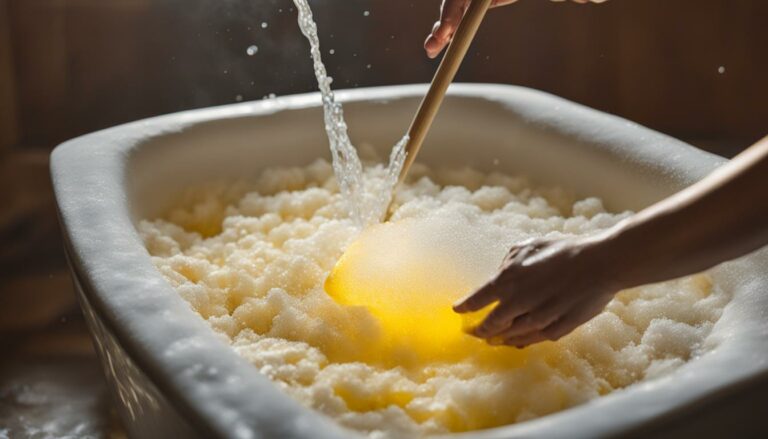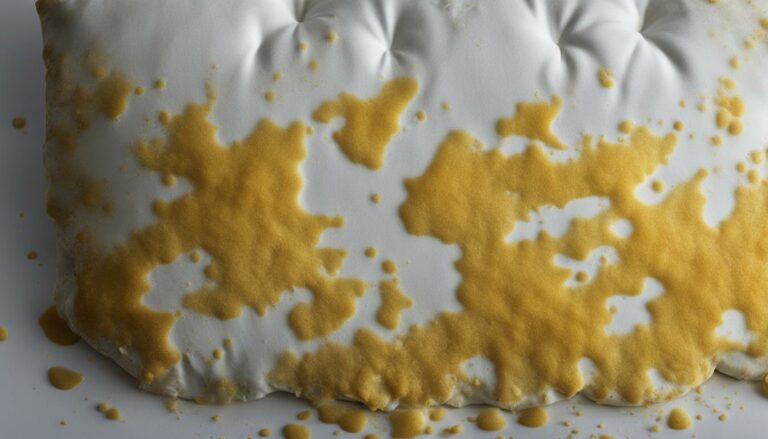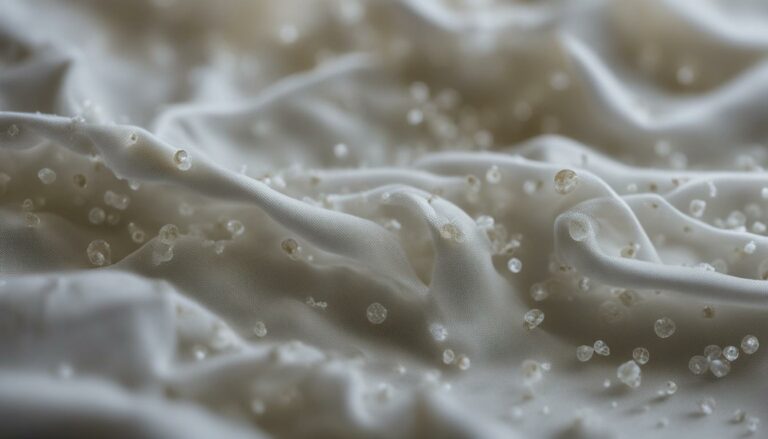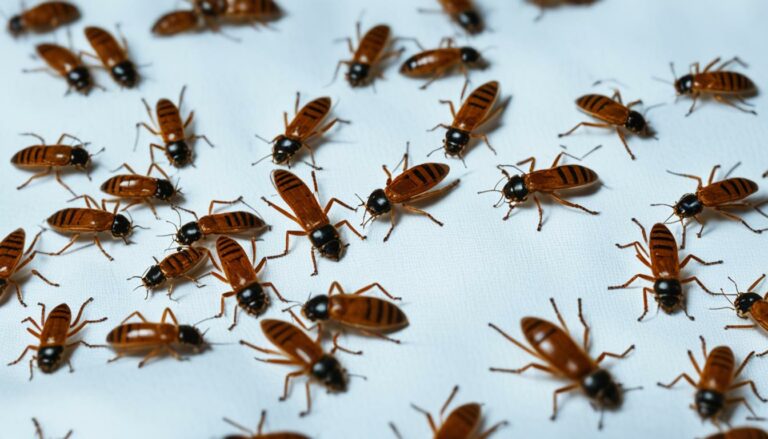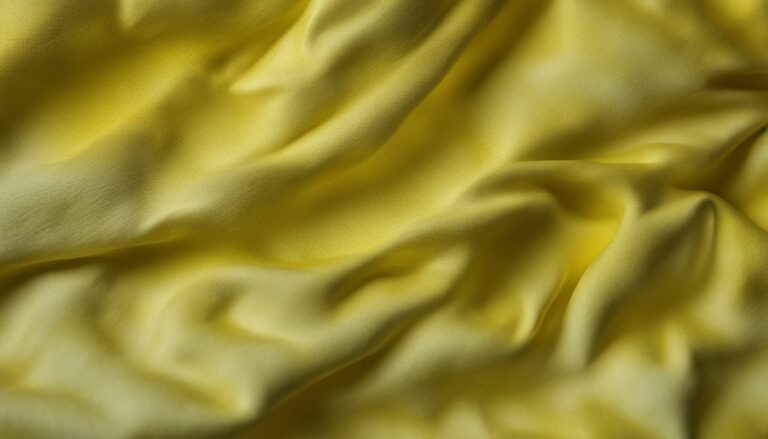Banish Yellow Stains from Pillows Effectively
Eric Christie stands as a luminary in the bedding industry, with a career spanning nearly four decades since the early 1980s. His journey through the world of bedding has seen him wear many hats – a manufacturer, designer, and retailer, showcasing his versatility and expertise in Read more...
pillowsandbedsheets.com and its partners may earn a commission if you purchase a product through one of our links
Yellow stains on pillows can be unsightly and frustrating to deal with. Whether they are caused by facial oils, sweat, saliva, or other factors, removing these stains requires the right cleaning methods and products. In this article, we will explore effective techniques for removing yellow stains from pillows and maintaining a clean, fresh sleeping environment.
Key Takeaways:
- Yellow stains on pillows are common and can be caused by factors like facial oils, sweat, and saliva.
- Using an enzyme-based stain remover is recommended for effectively removing yellow stains without causing further yellowing.
- Pre-treating the stained areas with mild liquid detergent, baking soda, or white vinegar can help break down the stains.
- Washing pillows according to the care instructions and using pillow protectors can prevent yellow staining.
- Yellow stains on pillows can harbor bacteria and allergens, impacting sleep hygiene and overall health.
Understanding the Science Behind Enzyme-based Cleaners
Enzyme-based cleaners are a powerful solution for removing yellow stains from pillows. These cleaners work by triggering chemical reactions that break down the molecules of stains, making them easier to remove. Unlike bleach-based stain removers, enzyme-based cleaners do not cause further yellowing, making them a safer option for preserving the appearance of your pillows.
Enzyme-based cleaners are especially effective at removing protein-based stains like sweat, which can often cause yellow discoloration on pillows. These cleaners not only eliminate stains but also neutralize odors, leaving your pillows fresh and clean.
By using enzyme-based cleaners, you can prevent yellowing on your pillows and extend their lifespan. The enzymes in these cleaners specifically target the molecules that cause yellow stains, ensuring a thorough and effective cleaning process.
In addition to their stain-removing abilities, enzyme-based cleaners are also a great choice for people with allergies or sensitivities. These cleaners do not contain bleach or harsh chemicals that can trigger reactions. Instead, they utilize natural enzymes to tackle stains and odors, making them a gentler option for sensitive individuals.
Tip: When using enzyme-based cleaners, it’s important to follow the instructions on the product label for best results.
With the understanding of how enzyme-based cleaners work, let’s explore the pre-treating methods for yellow-stained areas.
Pre-treating Yellow-Stained Areas
Before washing your pillows, it is important to pre-treat the yellow-stained areas. This will help to ensure effective stain removal and a fresh, clean result. Follow these simple steps to properly pre-treat yellow stains:
- Start by using cold water to soak the stained areas for about 30 minutes. This helps to prevent the stain from spreading further and prepares the fabric for the cleaning process.
- Create a solution of equal parts water and mild liquid detergent. This gentle yet effective mixture will help break down the yellow stains without causing damage to the fabric.
- Dab the stained area with a clean microfiber cloth or sponge, applying the solution to the fabric. Be careful not to rub the stain, as this can spread it further.
- For tougher stains, you can create a paste using baking soda and water. Apply the paste to the stained area and let it sit for 15-30 minutes. Baking soda is a natural stain remover that helps to lift and break down stubborn yellow stains.
- After allowing the paste to sit, rinse it off with water. You can also use white vinegar to help lift the stain and remove any residue. Simply dampen a clean cloth with white vinegar and blot the stained area.
Pre-treating yellow-stained areas is an essential step in the stain removal process. By following these pre-treatment steps, you can effectively prepare your pillows for washing and ensure a successful stain removal outcome.
Washing and Drying the Pillows
After pre-treating the stains, it is time to wash and dry the pillows. Check the care labels on your pillows to determine if they are machine washable or require hand washing.
For machine washable pillows:
- Wash them at a temperature of 40 degrees using a non-bio detergent.
- Use a gentle spin cycle and rinse thoroughly.
If your pillows are not machine washable:
- Hand wash them in a tub filled with hot water and a quarter cup of laundry detergent.
- Rinse them thoroughly and squeeze out the excess water without wringing them.
Dry the pillows:
- Air-dry them in direct sunlight.
- Or use a low heat setting in the dryer.
Consider using wool dryer balls or tennis balls to fluff the pillows while drying.
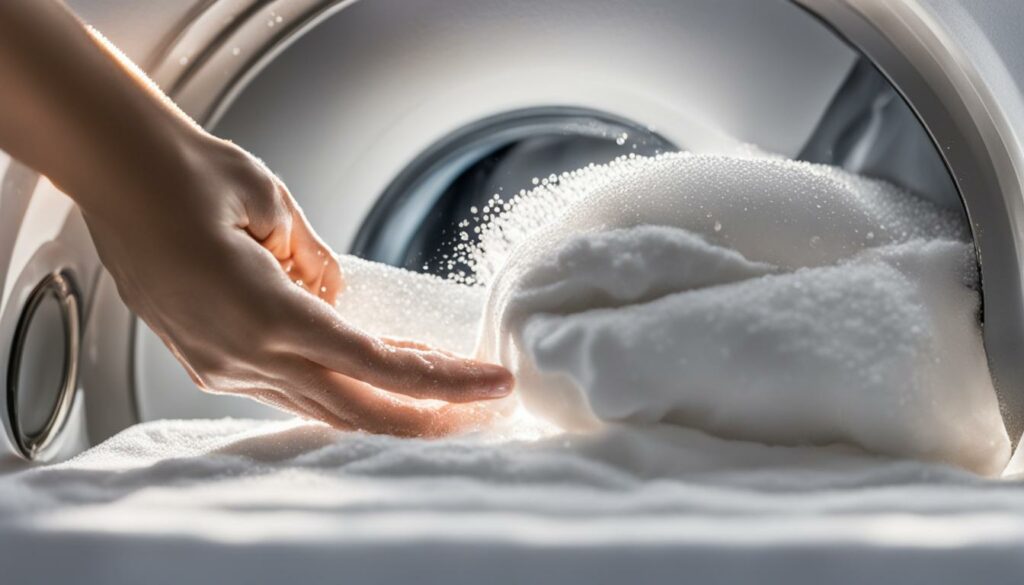
Preventing Yellow Stains on Pillows
To prevent yellow stains from occurring on your pillows, it is recommended to use pillow protectors. These washable pillowcases act as a barrier and prevent stains from forming and spreading. By using pillow protectors, you can keep your pillows cleaner for longer, reducing the chances of yellow staining.
In addition to using pillow protectors, it is essential to regularly wash your pillows. Pillowcases should be changed and washed at least once a week to maintain their cleanliness. This helps to remove any sweat, oils, or other substances that can cause staining.
When it comes to washing the pillows themselves, it is recommended to follow the care instructions provided by the manufacturer. Most pillows can be machine washed every 4 to 6 months to remove built-up dirt and sweat. Be sure to use a gentle cycle and a mild detergent that won’t damage the fabric or filling.
If your pillows are not machine washable, you can still keep them clean by spot cleaning regularly. Use a mild detergent and water solution to gently clean the stained areas. Avoid soaking the entire pillow, as this can lead to clumping and affect its shape.
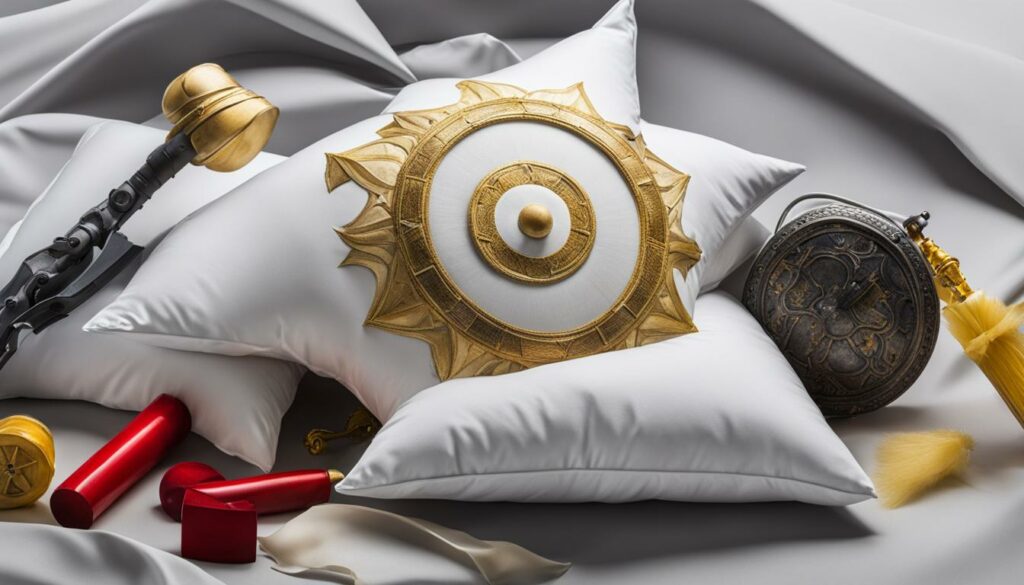
By taking proactive measures to prevent pillow staining and regularly washing your pillows, you can ensure that they stay clean, fresh, and free from unsightly yellow stains. Remember to use pillow protectors as a preventative measure, and follow the care instructions provided by the manufacturer to maintain the longevity of your pillows.
Common Causes of Yellow Stains on Pillows
Yellow stains on pillows can be caused by various factors that you may not even realize. Understanding the common causes can help you prevent and effectively remove these unsightly stains. Here are some of the main culprits:
Sweat Stains
One of the primary causes of yellow stains on pillows is sweat. When we sleep, our bodies naturally produce sweat, and over time, it can accumulate on our pillows. The combination of sweat and body oils can lead to noticeable yellow stains.
Saliva Stains
As unappealing as it may sound, saliva stains can also contribute to the yellowing of pillows. During sleep, saliva can seep through pillowcases, especially if you tend to drool. Over time, these stains can become more prominent.
Makeup Stains
If you wear makeup to bed or use skincare products that contain oils, they can transfer onto your pillowcases. The oils from these products can leave behind stains that can gradually turn yellow with time.
Inadequate and Infrequent Washing
Another common cause of yellow stains on pillows is inadequate and infrequent washing. When you don’t wash your pillowcases or pillows regularly, sweat, oils, saliva, and makeup residues build up, resulting in unsightly stains.
Now that you know the common causes of yellow stains, it’s important to take proactive measures to prevent them. Regularly washing your pillowcases, using protective pillow covers, and practicing good hygiene can go a long way in keeping your pillows fresh and stain-free.
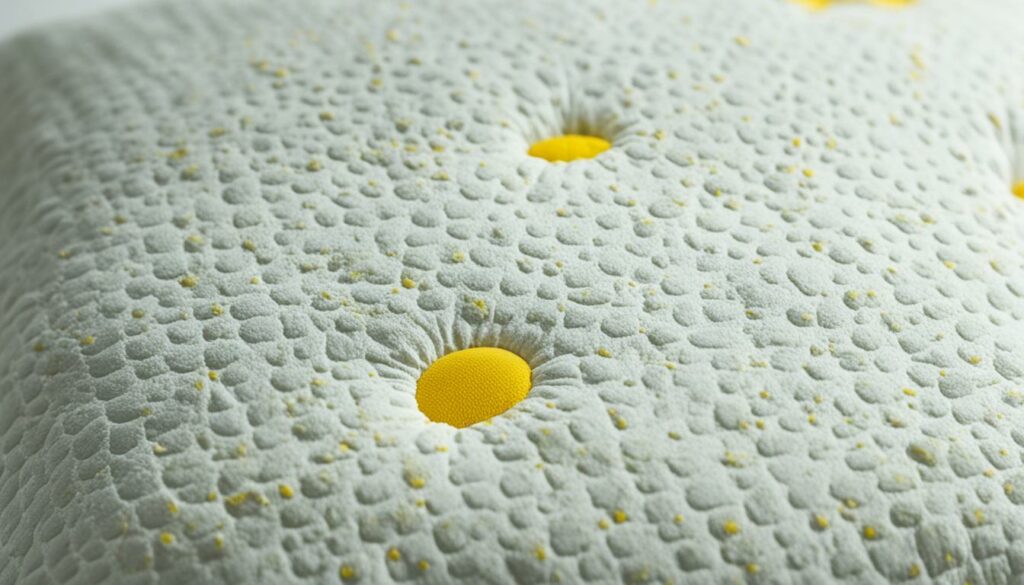
Whiten Yellow Pillows without Bleach
If you prefer not to use bleach, there are alternative methods to whiten yellow pillows. You can try using common household ingredients such as baking soda, vinegar, hydrogen peroxide, or lemon juice. These natural remedies are effective in removing stains and brightening your pillows.
Baking Soda Paste
Mix a small amount of baking soda with water to create a paste. Apply the paste to the yellowed areas of the pillow and let it sit for 15-30 minutes. Baking soda is a natural abrasive that can help lift stains and eliminate odors.
Vinegar Blotting
Take a clean cloth and dampen it with white vinegar. Gently blot the stained areas of the pillow to help lift the yellow stains. Vinegar is known for its stain-removing properties and can effectively break down the molecules that cause discoloration.
Hydrogen Peroxide or Lemon Juice Solution
Create a mixture using equal parts hydrogen peroxide and water. Alternatively, you can mix lemon juice with salt. Apply the solution to the yellowed areas of the pillow and let it sit for some time. Hydrogen peroxide and lemon juice are natural bleaching agents that can help whiten the fabric.
After using any of these methods, thoroughly rinse the pillow with water to remove any residues. Allow the pillow to air dry completely before using it again.

Using these natural methods, you can effectively whiten your yellow pillows without the use of bleach. Remember to always test these solutions on a small, inconspicuous area of the pillow first to ensure compatibility with the fabric.
Importance of Removing Yellow Stains on Pillows
Yellow stains on pillows not only affect the aesthetics of your bedding but also pose potential health risks. If left untreated, these stains can become a breeding ground for bacteria and allergens, compromising your sleep environment and overall well-being.
Unwashed pillows, especially those with yellow stains, can accumulate dust mites, dead skin cells, fungal spores, and various bacteria over time. These microscopic organisms thrive in the warm and moist conditions provided by unwashed pillows, increasing the risk of respiratory issues like hay fever and even triggering asthma attacks.
Regularly removing yellow stains from pillows is crucial to maintain a clean and healthy sleeping environment. By eliminating the bacteria and allergen buildup associated with these stains, you can reduce the risk of respiratory allergies and create a more hygienic space for restful sleep.
If the yellow stains on your pillows are beyond cleaning, it may be time to consider replacing them. Investing in new, clean pillows will ensure that you have a fresh and allergen-free sleep surface, promoting better sleep quality and overall health.
Health Impact of Yellow Stains
| Health Risks | Potential Symptoms |
|---|---|
| Bacterial buildup | Respiratory infections |
| Allergen accumulation | Hay fever, sneezing, nasal congestion |
| Dust mite infestation | Allergic reactions, asthma attacks |
Using Dishwasher Tablets for Yellow Stain Removal
If you’re dealing with stubborn yellow stains on your pillows, dishwasher tablets can be a game-changer. Along with specific cleaners, dishwasher tablets offer a powerful solution for removing these stains effectively.
For machine washable pillows, start by creating a solution with white vinegar and other cleaning agents. This mixture will help break down the stains and lift them from the fabric. Add the solution to the washing machine along with the pillows and wash them using hot water.
If your pillows require hand washing, you can still benefit from the cleaning power of dishwasher tablets. Create a solution by combining laundry detergent, washing soda, and dish detergent. Apply the solution to the yellow-stained areas on your pillows before washing them in a tub of hot water.
By using dishwasher tablets and specific cleaners, you can effectively clean and whiten your yellow-stained pillows. Say goodbye to unsightly stains and enjoy fresh, clean pillows once again.
Remember to always follow the care instructions provided with your pillows to ensure safe cleaning and optimal results.
Hand Washing Method for Yellow Stain Removal
For pillows that require hand washing, you can effectively remove yellow stains using a mild detergent and hot water. Here’s a step-by-step guide on how to do it:
- Fill a large tub with hot water, ensuring it is not boiling as it can damage the fibers of the pillows.
- Add a quarter cup of mild laundry detergent to the hot water. If your pillows are heavily soiled, you can also add a quarter cup of bleach or Borax.
- Soak the pillows in the soapy water, making sure they are fully submerged.
- Gently knead the pillows to allow the detergent to work through the material and break down the stains.
- After soaking for some time, rinse the pillows under cold water to remove any remaining soap and dirt residue.
- Squeeze out the excess water from the pillows without wringing them, as this can cause damage.
- To dry the pillows, you can either air dry them by laying them flat on a clean surface or use a low heat setting in the dryer, if it is safe to do so.
Hand washing your pillows with a mild detergent, hot water, and proper rinsing will help remove yellow stains and restore their freshness.
Tips:
- Always check the care labels on your pillows to ensure they can be hand washed.
- If your pillow is made of delicate materials or has specific washing instructions, it is best to consult the manufacturer’s guidelines.
Remember, hand washing provides precise control over the cleaning process, making it an effective method for removing yellow stains and restoring the cleanliness of your pillows.
Maintaining Fresh and Stain-Free Pillows
To keep your pillows fresh and stain-free between washes, it is important to maintain good pillow hygiene. A key step in pillow maintenance is encasing your pillows in pillow protectors, which act as a barrier against sweat, oils, and other stains. It is recommended to change these protectors at least once a week, along with your pillowcases.
In addition to using pillow protectors, consider using a linen spray when changing your pillowcases. Simply spray a light mist of your favorite scent onto the pillow surface before putting on the fresh pillowcase. This will not only make your pillows smell fresh and inviting but also help prolong the time between washes.
When it comes to washing your pillows, it is essential to follow the washing instructions on the care labels. For machine washable pillows, use a gentle cycle and a whitening agent at least twice a year to remove any stains and maintain the brightness of your pillows. For pillows that require hand washing, use a mild detergent and lukewarm water to gently clean them.
By practicing regular pillow maintenance and following proper cleaning techniques, you can ensure that your pillows stay fresh and free from stains. With a little effort and care, you’ll be able to enjoy a comfortable and hygienic sleeping environment.
FAQ
How do I remove yellow stains from my pillows?
To remove yellow stains from pillows, pre-treat the stained areas with a solution of water and mild liquid detergent or a paste of baking soda and water. Rinse the stain with water or dab it with white vinegar. Then, wash the pillows following the care instructions, either in a machine or by hand. Dry them thoroughly before use.
Can enzyme-based cleaners remove yellow stains from pillows?
Yes, enzyme-based cleaners are effective at removing yellow stains from pillows. They break down the molecules of the stains and neutralize any odors without causing further yellowing. These cleaners can be used as a pre-treatment before washing the pillows.
What are the common causes of yellow stains on pillows?
Yellow stains on pillows can be caused by sweat, natural body oils, saliva, makeup, and inadequate or infrequent washing. Understanding these causes can help in preventing and effectively removing yellow stains.
How can I prevent yellow stains from forming on my pillows?
You can prevent yellow stains on pillows by using pillow protectors that act as a barrier, regularly washing your pillows, and washing your pillowcases at least once a week. These practices help maintain cleanliness and prevent staining.
Can I whiten yellow pillows without using bleach?
Yes, you can whiten yellow pillows without using bleach. Baking soda, white vinegar, hydrogen peroxide, and lemon juice can be used to create natural whitening solutions that effectively remove stains without causing further yellowing.
Why is it important to remove yellow stains from pillows?
Yellow stains on pillows can harbor bacteria and allergens, leading to health issues like hay fever and asthma. Removing yellow stains helps maintain a clean and healthy sleeping environment.
How can dishwasher tablets be used to remove yellow stains from pillows?
Dishwasher tablets can be used in combination with specific cleaners as a stain removal method for machine washable pillows. The pillows are treated with a solution containing white vinegar and other cleaning agents before being washed in the machine with hot water.
What is the hand washing method for removing yellow stains from pillows?
For pillows that require hand washing, you can create a solution using hot water and a mild detergent. Soak the pillows, gently knead them, rinse thoroughly, and air dry or use a low heat setting in the dryer if safe.
How do I maintain fresh and stain-free pillows?
To maintain fresh and stain-free pillows, encase them in pillow protectors, change pillowcases regularly, use linen spray while changing pillowcases, and follow the care instructions provided. Regular pillow maintenance and proper cleaning techniques are essential.
Eric Christie stands as a luminary in the bedding industry, with a career spanning nearly four decades since the early 1980s. His journey through the world of bedding has seen him wear many hats – a manufacturer, designer, and retailer, showcasing his versatility and expertise in Read more...



